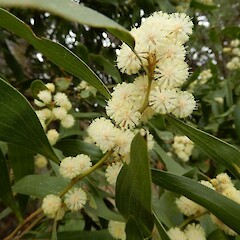Acacia melanoxylon
Common name
blackwood
Family
Fabaceae
Flora category
Vascular – Exotic
Structural class
Trees & Shrubs - Dicotyledons
NVS code
The National Vegetation Survey (NVS) Databank is a physical archive and electronic databank containing records of over 94,000 vegetation survey plots - including data from over 19,000 permanent plots. NVS maintains a standard set of species code abbreviations that correspond to standard scientific plant names from the Ngä Tipu o Aotearoa - New Zealand Plants database.
ACAMEL
Conservation status
Not applicable
Habitat
Waste places, often coastal, especially near plantations.
Wetland plant indicator status rating
Information derived from the revised national wetland plant list prepared to assist councils in delineating and monitoring wetlands (Clarkson et al., 2021 Manaaki Whenua – Landcare Research Contract Report LC3975 for Hawke’s Bay Regional Council). The national plant list categorises plants by the extent to which they are found in wetlands and not ‘drylands’. The indicator status ratings are OBL (obligate wetland), FACW (facultative wetland), FAC (facultative), FACU (facultative upland), and UPL (obligate upland). If you have suggestions for the Wetland Indicator Status Rating, please contact: [Enable JavaScript to view protected content]
FACU: Facultative Upland
Occasionally is a hydrophyte but usually occurs in uplands (non-wetlands).
Detailed description
Shrub or tree, twigs ribbed, glabrous to densely hairy. Leaves reduced to phyllodes, narrowly obovate up to 100 x 20 m, with 3-4 prominent veins. Bi-pinnate juvenile foliage may be present and individual leaves can have intermediate foliage with bipinnate foliage and a well developed phyllode. Inflorescence consists of many pale creamy yellow flowers in globbse heads, held singly or in racemes. Seed pod is glabrous, twisted or spiralled, 8-10 cm long (up to 4 cm diameter) and 5-8mm wide.
Similar taxa
Can be distinguished form other naturalised sp. by the large phyllodes and the pale creamy yellow flowers in globbose heads.
Flowering
August, September, October, November
Flower colours
Cream, Yellow
Year naturalised
1918
Origin
E. Australia, Tasmania
Etymology
acacia: Derived from Greek ‘akazo’ to sharpen, meaning point; spine or thorn.
melanoxylon: Black wood






